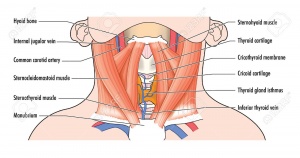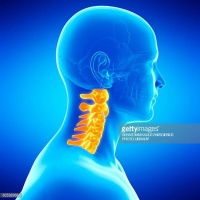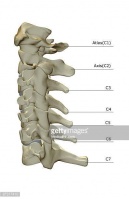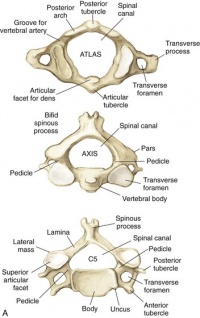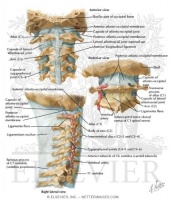Structure and Function of the Cervical Spine: Difference between revisions
No edit summary |
No edit summary |
||
| Line 19: | Line 19: | ||
Spine [01 Aug 1991, 16(8):861-869] | Spine [01 Aug 1991, 16(8):861-869] | ||
</ref> | </ref> . | ||
==== '''For more details about cervical vertebrae anatomy,please follow this link''' : [https://www.physio-pedia.com/index.php?title=Cervical_Vertebrae&oldid=174634 https://www.physio-][[pedia.com]]/index.php?title=Cervical_Vertebrae&oldid=174634. ==== | ===== '''For more details about cervical vertebrae anatomy,please follow this link''' : [https://www.physio-pedia.com/index.php?title=Cervical_Vertebrae&oldid=174634 https://www.physio-][[pedia.com]]/index.php?title=Cervical_Vertebrae&oldid=174634. ===== | ||
=== '''Cervical spine joints:''' === | === '''Cervical spine joints:''' === | ||
Revision as of 17:16, 9 May 2018
- Introduction:
Cervical spine spine starts at base of skull superiorly,ends above thoracic spine inferiorly and it could be called (neck).Neck joins head with trunk and limbs and it works as a major conduit for structures between them. Flexibility of neck movement allows and maximise necessary positions to head functions and its sensory organs. There are many important structures in neck area like nerves, muscles,arteries,veins, vertebrates, lymphatics,glands, oesophagus and trachea. Due to these important structures and lack of bony protection in neck area,it is considered as a region of vulnerability. The main arterial blood supply for head and neck is carotid arteries and principal venous drainage is jugular veins.Carotid and Jugular are commonly injured in penetrating wound of neck. Brachial plexues of nerves originates in neck and travels inferiorly to upper limb. In anterior aspect of neck,there is thyroid cartilage (largest cartilage of thyroid and trachea)[1].
Bony Structure of Neck:[edit | edit source]
It consists of 7 cervical vertebrates from C1 to C7, hyoid bone,manubrium of sternum and clavicles[1]. Cervical spine has a lordotic curve ( C shaped curve )[2]. According to peculiarities of cervical vertebrates,it could be divided in to two groups:[3]
- Superior cervical group: made up by C1 and C2.
- Inferior cervical group: made up by C3 to C7.
Superior cervical Group:[edit | edit source]
C1 called atlas and C2 called axis and they have some differences than other vertebrae, Atlas C1 is ring like shape , it has no body and no spinous process,
C2 looks like other cervical vertebrae but most distinctive feature is odontoid process or tooth which placed vertically on superior surface of vertebral body[4] with two articular facets( anterior and posterior) which articulate with atlas bone and atlas transverse ligament. C2 has smaller and triangular vertebral foramen.
Inferior Cervical Group:[edit | edit source]
It is made up of 5 vertebrea from C3 TO C7 with similar characteristics like smaller vertebral body with two rafes at lateral sides directed Superiorly called spinous processes,two pedicles directed backwards and transverse process located anteriorly.C7 may be considered typical or atypical but has two distinct features. The first is that unlike the rest of the cervical vertebrae, is that the vertebral artery does not traverse the transverse foramen. The second is that it contains a long spinous process, also known as “vertebra prominens.”[5] .
For more details about cervical vertebrae anatomy,please follow this link : https://www.physio-pedia.com/index.php?title=Cervical_Vertebrae&oldid=174634.[edit | edit source]
Cervical spine joints:[edit | edit source]
Joints between vertebrae are made for spine mobility, Movements of superior cervical spine joint and inferior cervical spine joints functionally completing each others allowing movements like rotation,flexion,extension and inclination of head.[4]
Superior cervical spine joints:
- Atanto-occipital joint :is aligned to permit movement of nodding[6] (Flexion and extension) and turning(Lateral flexionand rotation)peculiar at this level. For more details please follow this link, Index.php?title=Atlanto-occipital joint&oldid=184161.
- Atlanto- Axial joint :Allows about 50% of cervical rotation,flextion about 10 degrees and limited extention. For more details please follow this link: Index.php?title=Atlanto-axial joint&oldid=174590
Intervertebral -joints:[edit | edit source]
Apophyseal Joints:[edit | edit source]
Ligaments of Cervical Spine:[edit | edit source]
- Occipitovertebral ligaments :[edit | edit source]
References:[edit | edit source]
- ↑ 1.0 1.1 Lang, J., 1993. Clinical anatomy of the cervical spine. Stuttgart; New York: Thieme.
- ↑ Cervical Spine Anatomy. University of Maryland Clinical Center. http://www.umm.edu/programs/spine/health/guides/cervical-spine-anatomy. accessed Apirl 2018.
- ↑ Spine, S.C., 2015. Anatomy of the Cervical Spine. Cervical Spine: Minimally Invasive and Open Surgery, p.1.
- ↑ 4.0 4.1 Spine, S.C., 2015. Anatomy of the Cervical Spine. Cervical Spine: Minimally Invasive and Open Surgery, p.1.
- ↑ Panjabi MM , Duranceau J , Goel V , Oxland T , Takata K Spine [01 Aug 1991, 16(8):861-869]
- ↑ Jeffreys, E., 2013. Disorders of the cervical spine. Butterworth-Heinemann.
